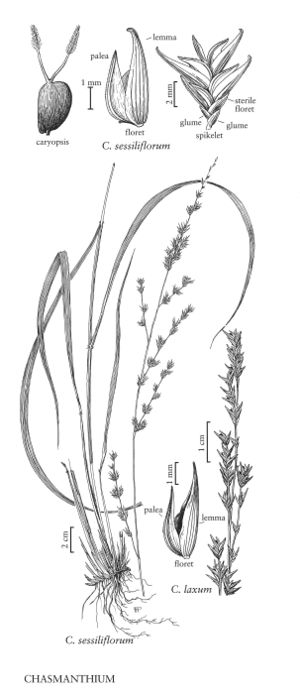Chasmanthium sessiliflorum
Culms 60-150 cm, (1)2-3.5 mm thick at the nodes, unbranched, leafy for 40% of their height. Sheaths pilose; collars pilose; ligules 0.2-0.3 mm, entire; blades (15)20-50 cm long, 4.5-9.5(15) mm wide, linear-lanceolate, sparsely pilose adaxially. Panicles (9)20-70 cm, contracted or open, erect; branches tightly appressed or ascending to strongly divergent; axils of panicle branches glabrous or scabridulous at the edges; pedicels 0.3-2.5(5) mm. Spikelets 4-10 mm long, 6-9 mm wide, with 4-7(8) florets, lower 1(2) florets sterile, fertile florets divergent to 80°. Lower glumes 1.2-2.7 mm, 3-5-veined; upper glumes 1.4-2.2 mm, 3-5-veined; calluses glabrous; fertile lemmas 3.5-5.9 mm, usually curved or irregularly contorted, 7-9-veined, keels not winged, apices scabridulous; paleas 2.8-4 mm; anthers (0.8)1.3-1.6 mm, varying in length within a spikelet. Caryopses 2-2.5 mm, exposed at maturity. 2n = 24.
Distribution
Va., Okla., Miss., Tex., La., Mo., Ala., Tenn., N.C., S.C., Ark., Ga., Fla.
Discussion
Chasmanthium sessiliflorum grows in rich woods, meadows, and swamps, especially on the coastal plain. It grows throughout most of the southeastern United States.
Selected References
None.
